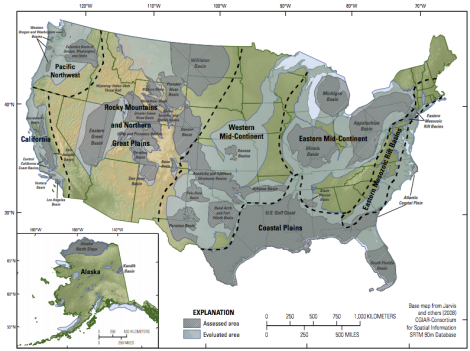
Radoslaw Maciejewski / ShutterstockWe could store CO2 underground, though not in the London Underground.
We could liquefy and cram our carbon dioxide emissions into the ground for some 500 years before America’s geologic basins started to overflow with the stuff.
That’s according to a new assessment by federal scientists, who spent years scouring America for porous rocks thousands of feet beneath the ground that might be appropriate for carbon sequestration.
They studied 36 geologic basins that could be suitable and found that the best region for storing waste CO2 would be the Gulf Coast. From the Houston Chronicle:
Brenda Pierce, energy resources program coordinator for the U.S. Geological Survey, … said one reason the Gulf is attractive is its relative lack of fresh groundwater, since any area with fresh groundwater was eliminated as a potential storage site. In addition, only rock layers deep enough to keep carbon dioxide under sufficient pressure to remain liquid and to prevent it from escaping were considered a good fit.
But just because the storage space is available doesn’t mean that the approach would be feasible. Or safe.
The scientists say the 36 potential underground storage spots might be able to hold roughly 3,000 metric gigatons of liquefied CO2. For context, the U.S. releases between 5 and 6 metric gigatons of CO2 every year from power plants, vehicles, and other spots where fuel is burned to produce energy.
Two-thirds of the total storage potential was found to be in the Coastal Plains region, mostly along the Gulf Coast. The dark gray spots on this map show the areas that were assessed:
But most of America’s CO2 emissions come from coal-burning power plants that are located far from the Gulf. To get the CO2 from the power plants to the Gulf, it would need to be ferried through pipelines, and that would be a costly proposition. From Platts:
[T]he study clearly shows that the basins with the highest potential for carbon storage are away from the Southeast region, Mid-Atlantic and Ohio Valley, which accounts for 65% of the US’ coal-fired capacity, according to the US Energy Information Administration. This means that despite the US storage potential, infrastructure needs — including a number of new pipelines which need to be built to connect power plants, compression stations and these basins — could make geologic sequestration costly.
De Smog Blog points to even more financial hurdles:
According to a database maintained at MIT’s Carbon Capture and Sequestration Technologies program, there are currently six large scale CCS projects underway in the United States. Five of the six projects are still in the planning phase, with one project listed as under construction. The current projected price tag of these six projects is a whopping $16.7 billion.
That’s a lot to gamble on a risky technology that continues to struggle to prove it’s even possible to deploy on a global scale. And $16.7 billion is only the opening bet. A full scale deployment of CCS technology across the entire US would likely be in the hundreds of billions. Estimates run as high as $1.5 trillion a year to deploy and operate enough carbon capture and storage worldwide to significantly reduce carbon emissions from the fossil fuels we consume.
It’s also worth remembering that carbon sequestration can trigger earthquakes. Tremblers at CCS sites could not only cause physical damage around them, but release sequestered CO2 back into the atmosphere, thereby making the whole effort futile.
And who knows what other problems might arise in the decades or centuries to come from stuffing all that liquefied CO2 into the ground.
Still, considering the massive threat posed by climate change, carbon sequestration is worth investigating. “The United States has the ability to store a lot of carbon dioxide,” Interior Secretary Sally Jewell said in a conference call with reporters Wednesday. “If this proves to be economically viable — and that hasn’t been answered in this study — sequestration could help.”
That said, there would be no carbon dioxide emissions to store if we switched over to renewables.




